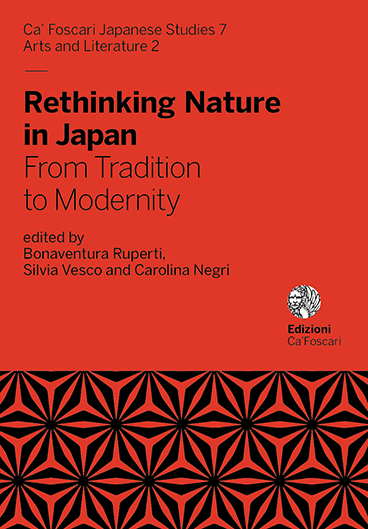Series |
Ca’ Foscari Japanese Studies
Edited book | Rethinking Nature in Japan
Chapter | The Idea of Tsukuri yama
The Idea of Tsukuri yama
Reimagining Mountains through Aragoto, the Style of Superhuman Strength in Kabuki
Abstract
This paper reports the most fundamental ideas of mountains in Japanese tradition from aragoto in Edo period Kabuki. Created and pioneered by Ichikawa Danjūrō I 初代市川団十郎 in the late seventeenth century, the rough style of Kabuki known as aragoto is characteristic of Kabuki in the Edo region (modern-day Tōkyō), contrasting the wagoto or soft style of the Kyōto-Ōsaka region. Many of the 18 best plays of the Ichikawa family are aragoto style performances and are still performed nowadays as specialities of the Ichikawa school. The style of aragoto during the Genroku era (1688-1704) – with its origin in performances of oni, or ogres, in local festival grounds – was mostly set in the mountainous areas where these ogres were believed to have dwelled. Setups for festivals, yama, which literally means ‘mountain’ in Japanese, or tsukuri yama つくり山 (reimagining mountains), serve as scenography representing the mountains. These yama have been created in various forms as places for Japanese kami, spirits or phenomena worshipped in folk beliefs, as far back as the tenth century. The stages for the ancient performing art called kagura and yama such as the Yamaboko float of the Kyōto Gion Festival and the Yamagasa float in Hakata are considered to be central to festivals. This paper aims to point out the folkloric mind-set behind yama, that is mountains as the manifestation of kami, using images of aragoto, oni and yama.
Submitted: Oct. 7, 2016 | Accepted: Dec. 9, 2016 | Published Dec. 15, 2017 | Language: en
Keywords Furyū • Mitate • Yama • Oni • Aragoto • Tsukuri yama • Kagura • Kinpira jōruri
Copyright © 2017 Eri SATO. This is an open-access work distributed under the terms of the Creative Commons Attribution License (CC BY). The use, distribution or reproduction is permitted, provided that the original author(s) and the copyright owner(s) are credited and that the original publication is cited, in accordance with accepted academic practice. The license allows for commercial use. No use, distribution or reproduction is permitted which does not comply with these terms.
Permalink http://doi.org/10.14277/6969-171-3/CFJS-7-9
